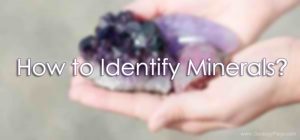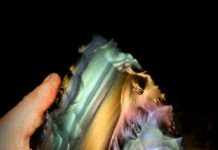
There are over 4,000 known minerals, and approximately 80-100 new ones are discovered each year. Of all these, only a few hundred are considered common.
To help with identification, geologists must look closely at the physical properties of a mineral. These properties can include: color, streak, hardness, cleavage, specific gravity, crystal form, and others.
Color
The color of a mineral is the most important identifying characteristic for the amateur mineralogist. Many minerals exhibit various colors; the varieties are mainly due to impurities or a slight change in chemical composition. For example, calcite can be white, blue, yellow, pink, or fluorescent. Surface tarnish may have changed the color of the specimen; therefore, a fresh surface should be examined.
Hardness
Hardness is a measure of a mineral’s resistance to abrasion. A numerical value for hardness is determined using a scale that ranges from 1 (softest) to 10 (hardest). Developed by a German mineralogist, Friedrich Mohs, the Mohs Hardness Scale assigns hardness values to 10 representative minerals as well as other common materials (penny, knife blade, etc.). Talc is the softest mineral and diamond is the hardest mineral.
Most of the minerals you will encounter will be between 2 and 7.
If a mineral can be scratched with a copper penny, but cannot scratch glass, then your mineral has a hardness between 3-6.
Luster
Luster refers to the brightness of light reflected from the mineral’s surface. The main types of luster are metallic and nonmetallic. Some of the more important nonmetallic lusters are:
- Adamantine: brilliant, like that of a diamond.
- Earthy: dull, like kaolin.
- Silky: having the sheen of silk, like satin spar, a variety of gypsum.
- Greasy: oily appearance.
- Resinous: waxy appearance, like sphalerite.
- Vitreous: the appearance of broken glass, like quartz.
- Nacreous (pearly): like mother of pearl; for example, pearly luster on fossil gastropods and cephalopods.
Specific Gravity
Specific gravity is the relative weight of the mineral to an equal volume of water. For example, gold has a specific gravity of 15-19.3 and is thus 15 to 19.3 times as heavy as water. It is possible to make a fairly good estimate of specific gravity by checking the mineral’s weight in your hand.
Follow these simple instructions to determine the specific gravity of your mineral:
- Push the “Power” button on the digital scale. The scale should read 0.0 with nothing on it.
- Place your dry mineral on the scale and record its weight.
- Remove the mineral.
- Place a water-filled container on the scale and push the “tare” button to “zero” it out.
- Unwind paper clip and wrap it around the mineral, leaving enough of the paper clip to hold with your two fingers.
- Submerge the mineral in the water, but do not let it touch the bottom (important: be sure that your fingers are not touching or submerged in the water with your mineral specimen).
- Record the weight of the mineral submerged in the water.
- Take the original weight of the mineral and divide it by the weight of the mineral submerged in the water.
The quotient (answer) of the two weights is a mineral’s specific gravity.
Streak
A streak test is accomplished by rubbing the mineral on a porcelain plate, also known as a streak plate. The color of the streak left by the mineral is sometimes different from the color of the mineral itself. A streak test comes in handy when identifying minerals such as hematite. Hematite can be found in various colors from black to red, but it always leaves a red streak.
This can be produced by taking the mineral and scrapping it across the surface of a streak plate or something harder depending on the hardness of your mineral. The mineral’s color in powdered form can be a better indicator than its original color. When you have successfully achieved a powdered streak from your mineral.
Smell
Once you successfully get a streak from a mineral now is a good time to smell it. Some minerals that contain sulfur, for instance, have a very distinct smell (rotten eggs).
Taste
Minerals that are translucent or transparent are good candidates for a taste test. Halite, for example, has a very salty taste. It is made up of sodium and chlorine (NaCl), which is also referred to as rock salt.
To taste the mineral simply stick out your tongue and touch the tip of it to the mineral.
Magnetism
A few minerals, such as magnetite and pyrrhotite, are attracted by a magnet and are said to be magnetic. Magnetic minerals are rare in Kentucky, but do occur in the kimberlite in Elliott County. If you find a large piece of highly magnetic material, it may be a meteorite or a furnace product.
Use a small magnet and run it across the mineral. If the magnet is attracted to the mineral then your mineral is magnetic.
Acid Test
When carbonates (especially calcite) are treated with cold, dilute hydrochloric acid, they will effervesce, foam, and bubble, and give off carbon dioxide gas. When sulfides, such as galena, pyrite, and sphalerite, are treated with dilute hydrochloric acid, they will give off the rotten-egg odor of hydrogen sulfide.
Cleavage and Fracture
Cleavage can be observed in minerals that tend to break along one or more flat surfaces or planes. The number of cleavage planes, and their orientations relative to each other, can be diagnostic of particular minerals. Minerals that display cleavage include: calcite, halite, fluorite, topaz, and galena. However, not all minerals have cleavage, such as quartz and pyrite.
Minerals may have one, two, three, four, or six directions of cleavage. These cleavage forms are (1) cubic, (2) octahedral, (3) dodecahedral, (4) rhombohedral, (5) prismatic, and (6) pinacoidal. Minerals that break easily along these lines of weakness yield shiny surfaces. Many crystals do not cleave, but fracture or break instead. Quartz, for example, forms well-developed crystal faces but does not cleave at all; instead it fractures or breaks randomly with a conchoidal fracture.
Cleavage Types:
- Perfect: produces smooth surfaces
- Imperfect: produces planes that are not smooth
- Poor: less regular
Some minerals do not readily break along its cleavage planes. This type of breakage is called a fracture. How a mineral fractures can also be used an indicator.
Fracture Types:
- Conchoidal: fracture surface is a smooth curve, often bowl-shaped (common in glass)
- Hackly: produces sharp jagged edges
- Uneven: surface is rough and irregular
- Fibrous: surface shows fibers or splinters
Crystal Form & Mineral Habit
Crystal form is responsible for the mineral’s geometric shape and arrangement of crystal faces. The crystal form will always remain the same in every sample found of the same mineral, although the crystal form is better displayed in some samples than in others. Sometimes, growth patterns, called the mineral habit, disguise the ideal form of the crystal. However, these habits can also aid in identification. Some commonly found habits include: botryoidal (which resembles a cluster of grapes), striated (parallel grooves on crystal faces), and acicular (needlelike).
Fluorescence
Some minerals, such as calcite, gypsum, halite, uranium minerals, and fluorite, will fluoresce in brilliant colors when viewed with an ultraviolet (UV) light. UV light is not normally visible to the human eye, and you should avoid looking directly at the UV source, as it can damage eyesight.
Tenacity
Tenacity is the measure of a mineral’s cohesiveness or toughness. Tenacity terms are:
- Brittle: breaks or powders easily; for example, pyrite or marcasite.
- Ductile: can be drawn into a wire; for example, copper.
- Elastic: bends and resumes its original position or shape when pressure is released; for example, biotite or muscovite.
- Malleable: can be hammered into thin plates or sheets; for example, gold or copper.
- Sectile: can be cut or shaved with a knife; for example, gypsum or galena.
Reference:
Utah Geological Survey: How do geologists identify minerals?
Kentucky Geological Survey: Methods Used in Identifying Minerals










